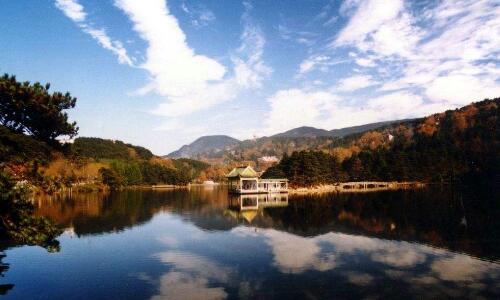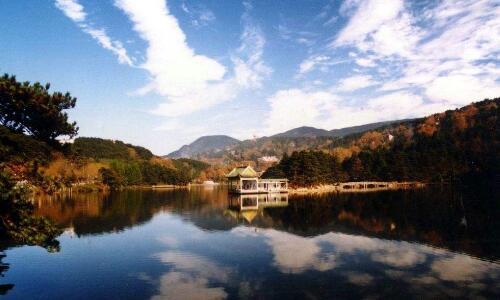
Jiangxi is one of China's mainland provinces. The name "Jiangxi" derives from Jiangnan Xidao (Circuit of Western Jiangnan) administrated under the Tang dynasty and its short name "Gan" derives from Ganjiang River, the largest one in the province. It covers an area of 166,900 square kilometers, has a total population of about 46 million, and governs 11 municipalities and 100 counties (county-level cities/districts). Jiangxi has 55 ethnic groups, among which the Han ethnic group accounts for over 99% of the total population.
Advantageous Geography
Jiangxi is located in the central part of Southeast China and on the south bank of the middle and lower reaches of the Yangtze River. In ancient times, Jiangxi was called "the head of Wu (now Hubei) and the tail of Chu (now Hunan)" and “the gate of Yue (now Guangdong) and the courtyard of Min (now Fujian)", so it is "the area of good shape". It borders on Zhejiang and Fujian provinces to the east, Guangdong to the south, Hunan to the west, and Hubei and Anhui to the north. Jiangxi is the heartland of Yangtze River Delta, Pearl River Delta and the south triangle area of Fujian and has a direct distance of 600 to 700 kilometers from many places of strategic importance and harbors, such as Shanghai, Guangzhou, Xiamen, Nanjing, Wuhan, Changsha, Hefei, etc. The total length of basically completed expressways within the province is 6,000 km, and the main accesses to other provinces are all expressways. Beijing-Kowloon Railway and Zhejiang-Jiangxi Railway run through the whole province. With seven airports, namely, Nanchang Changbei International Airport, Ganzhou Huangjin Airport, Jingdezhen Luojia Airport, Ji'an Jinggangshan Airport, Jiujiang Lushan Airport, Yichun Mingyueshan Airport, and Shangrao Sanqingshan Airport, and two harbors directly reaching major overseas harbors via Yangtze River, namely, Nanchang Harbor and Jiujiang Harbor, Jiangxi enjoys convenient air transport and waterway transport.
Beautiful Environment
"Lushan Mountain is world renowned for its quietness, Sanqingshan Mountain is world renowned for its elegance, and Longhushan Mountain is world renowned for its uniqueness." Near to the Tropic of Cancer and with a typical subtropical humid climate, Jiangxi as a whole is warm, has four distinctive seasons, sufficient sunshine and abundant rainfall, with an annual average temperature of 11.6℃ to 19.6℃, an annual average precipitation of 1,341 mm to 1,940 mm, and a long frost-free period. Jiangxi's urban ambient air quality meets the requirements for level II as specified in the national standards. With a forest coverage rate of 63.1%, Jiangxi is regarded as one of the "greenest provinces" in China, and one of the world centers of origin of plant, and a natural "big oxygen bar". Jiangxi has 4 world heritage sites, 4 world geoparks, 1 wetland of international importance, 18 state-level scenic spots, 10 state-level 5A-class tourist attractions, and 124 4A-class tourist attractions. Due to its good ecological basis and strong resources and environment carrying capacity, Jiangxi was selected as one of the first three national ecological civilization pilot areas.
Rich Cultural Heritage
Confucian culture resurged in Jiangxi, Zen culture took shape in Jiangxi and Taoist culture originated in Jiangxi. Under the nurture of these three kinds of culture, Jiangxi became a place of cultural prime and a state of literature and righteousness. Among the top eight great writers of the Tang and Song dynasties, Ouyang Xiu, Wang Anshi and Zeng Gong were natives of Jiangxi. Tao Yuanming's poem, Tang Xianzu's opera, Huang Tingjian’s calligraphy and Fu Baoshi's painting are shining pearls in the gems of Chinese culture and art. Jiangxi has four millennium sites renowned in both ancient and modern times, namely, the millennium ancient town Jingdezhen, the millennium pavilion Tengwang Pavilion, the millennium academy White Deer Grotto Academy and the millennium birthplace of Chinese Taoism Longhushan. Jiangxi is also well-known at home and abroad for its red culture. Jinggangshan is the cradle of the Chinese revolution, Nanchang is the birthplace of the People's Liberation Army of China, Ruijin is the capital of the Central Government of Chinese Soviet Republic, and Anyuan is the source of Chinese workers' movement.
Unique Natural Resource Endowments
Jiangxi is known as the World Capital of Tungsten, the Kingdom of Rare Earth and the World Capital of Porcelain - Jingdezhen. 193 kinds of mineral products have been discovered in Jiangxi, and the reserve of 111 kinds has been verified, and that of 13 kinds, such as copper, gold, silver and tantalum, rank the first in the country. Jiangxi has Asia's largest copper mine and tantalum and niobium ore. Jiangxi is creating Yingtan as the Green World Capital of Copper, Yichun as the Asian Capital of Lithium, and south Jiangxi as the World Capital of Tungsten and the Kingdom of Rare Earth. With abundant water resources and dense river network, Jiangxi has a total river length of about 18,400 kilometers and the China’s largest fresh water lake - Poyang Lake.
Prominent Strategic Position
Jiangxi is one of the important sources of the ancient Silk Road, an important hub connecting east with west in Yangtze River Economic Belt, the only way for westward movement of southeast coastal provinces and for eastward expansion of the midwest provinces, and the strategic connecting point of the "Silk Road Economic Belt" and the "21st Century Maritime Silk Road". Jiangxi is a pivot and highland for overlapping policies of key strategies, such as promoting rising in Central China, constructing Yangtze River Economic Belt, constructing national ecological civilization demonstration area, and revitalizing the former Central Soviet Area, etc.
(Source: Department of Commerce of Jiangxi Province)




 A single purchase
A single purchase









